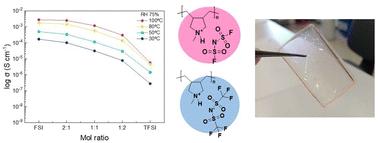当前位置:
X-MOL 学术
›
Polym. Chem.
›
论文详情
Our official English website, www.x-mol.net, welcomes your
feedback! (Note: you will need to create a separate account there.)
Protic poly(diallylmethylammonium) poly(ionic liquid) proton exchange membranes with low fluorine content
Polymer Chemistry ( IF 4.1 ) Pub Date : 2024-11-08 , DOI: 10.1039/d4py01099j Yuliana Pairetti, Antonela Gallastegui, Zaneta Wojnarowska, Marian Paluch, Ilaria Abdel Aziz, Nerea Casado, Luke A. O'Dell, Maria Forsyth, David Mecerreyes
Polymer Chemistry ( IF 4.1 ) Pub Date : 2024-11-08 , DOI: 10.1039/d4py01099j Yuliana Pairetti, Antonela Gallastegui, Zaneta Wojnarowska, Marian Paluch, Ilaria Abdel Aziz, Nerea Casado, Luke A. O'Dell, Maria Forsyth, David Mecerreyes

|
Proton exchange membranes (PEMs) are being studied as a key component to extend and improve green hydrogen technologies. One important issue nowadays is the need for reducing the amount of poly-fluoro alkyl substances (PFSA)s in materials employed in renewable energy devices due to their high toxicity. In the present work, we introduce a family of PFSA-free protic poly(ionic liquid)s based on cationic poly(diallylmethylammonium) (PolyDAMAH) and sulfonamides such as bis(trifluorosulfonyl)imide (TFSI) and bis(fluorosulfonyl)imide (FSI) as counter-anions. The synthesis was carried out in a three step procedure, first synthesizing the protic diallylammonium chloride monomer, then thermal radical polymerization and finally anion exchange of the chloride anion by the specified sulfonamide anions. The protic PolyDAMAH showed apparent molecular weights between 30 K and 40 K and glass transition values of 39 and 52 °C, respectively, for both homopolymers and high thermal stability up to 250 °C. From solid state NMR studies it was found that the FSI− anion may allow a faster proton and anion mobility when compared to the TFSI− anion in dry and humid states. To find the best match, blending protic poly(ionic liquid)s with TFSI− and FSI− anions improved the mechanical characteristics of the membranes, while maintaining low water uptake and high ionic conductivity. The optimized PolyDAMAH membranes were characterized by dielectric and mechanical relaxation measurements and showed more than six orders of magnitude decoupling of the ion dynamics from the mechanical relaxation. An ionic conductivity of 1.2 × 10−3 S cm−1 at 100 °C and 75% relative humidity with the storage modulus higher than 2.2 × 10−5 Pa at 80 °C was obtained for the optimized blend, making this a promising material to be employed as proton exchange membranes for fuel cells at intermediate temperatures.
中文翻译:

低氟含量的质子聚(二烯丙基甲基铵)聚(离子液体)质子交换膜
质子交换膜 (PEM) 正在被研究为扩展和改进绿色氢技术的关键组成部分。当今的一个重要问题是,由于多氟烷基物质 (PFSA) 的高毒性,需要减少可再生能源设备所用材料中多氟烷基物质 (PFSA) 的含量。在本工作中,我们介绍了一族基于阳离子聚(二烯丙基甲基铵)(PolyDAMAH)和磺胺类药物的无 PFSA 质子聚(离子液体),例如双(三氟磺酰基)酰亚胺 (TFSI) 和双(氟磺酰基)酰亚胺 (FSI) 作为反阴离子。合成分三步程序进行,首先合成质子二烯基氯化铵单体,然后进行热自由基聚合,最后通过指定的磺胺阴离子进行氯阴离子的阴离子交换。质子 PolyDAMAH 的表观分子量在 30 K 和 40 K 之间,玻璃化转变值分别为 39 和 52 °C,均聚物在高达 250 °C 的温度下具有很高的热稳定性。 从固体 NMR 研究中发现,与干燥和潮湿状态下的 TFSI− 阴离子相比,FSI− 阴离子可能允许更快的质子和阴离子迁移。为了找到最佳匹配,将质子聚(离子液体)与 TFSI - 和 FSI - 阴离子混合改善了膜的机械特性,同时保持了低吸水率和高离子电导率。优化后的 PolyDAMAH 膜通过介电和机械弛豫测量进行了表征,并显示出离子动力学与机械弛豫的解耦超过 6 个数量级。离子电导率为 1.优化混合物在 100 °C 和 75% 相对湿度下获得了 2 × 10-3 S cm-1,储能模量高于 2.2 × 80 °C 时 10-5 Pa,使其成为一种很有前途的材料,可用作中等温度下燃料电池的质子交换膜。
更新日期:2024-11-13
中文翻译:

低氟含量的质子聚(二烯丙基甲基铵)聚(离子液体)质子交换膜
质子交换膜 (PEM) 正在被研究为扩展和改进绿色氢技术的关键组成部分。当今的一个重要问题是,由于多氟烷基物质 (PFSA) 的高毒性,需要减少可再生能源设备所用材料中多氟烷基物质 (PFSA) 的含量。在本工作中,我们介绍了一族基于阳离子聚(二烯丙基甲基铵)(PolyDAMAH)和磺胺类药物的无 PFSA 质子聚(离子液体),例如双(三氟磺酰基)酰亚胺 (TFSI) 和双(氟磺酰基)酰亚胺 (FSI) 作为反阴离子。合成分三步程序进行,首先合成质子二烯基氯化铵单体,然后进行热自由基聚合,最后通过指定的磺胺阴离子进行氯阴离子的阴离子交换。质子 PolyDAMAH 的表观分子量在 30 K 和 40 K 之间,玻璃化转变值分别为 39 和 52 °C,均聚物在高达 250 °C 的温度下具有很高的热稳定性。 从固体 NMR 研究中发现,与干燥和潮湿状态下的 TFSI− 阴离子相比,FSI− 阴离子可能允许更快的质子和阴离子迁移。为了找到最佳匹配,将质子聚(离子液体)与 TFSI - 和 FSI - 阴离子混合改善了膜的机械特性,同时保持了低吸水率和高离子电导率。优化后的 PolyDAMAH 膜通过介电和机械弛豫测量进行了表征,并显示出离子动力学与机械弛豫的解耦超过 6 个数量级。离子电导率为 1.优化混合物在 100 °C 和 75% 相对湿度下获得了 2 × 10-3 S cm-1,储能模量高于 2.2 × 80 °C 时 10-5 Pa,使其成为一种很有前途的材料,可用作中等温度下燃料电池的质子交换膜。






























 京公网安备 11010802027423号
京公网安备 11010802027423号